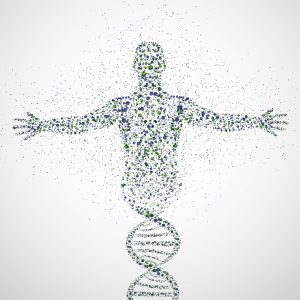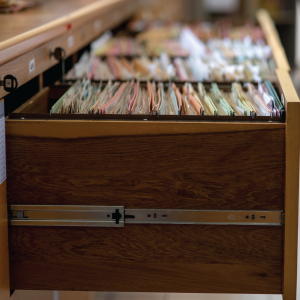
People use social media to solve all kinds of mysteries in their day-to-day lives. When is that party again? What exactly is going on with this big breaking news story? Where can I find more pictures of my adorable baby nephew?!
But you may not realize that geneticists have their very own social media, helping them solve some of the most challenging puzzles in genomics.
Web sites and tools like GeneMatcher and ClinVar allow scientists the world over to compare notes on individual genes, sometimes creating a body of evidence that allows for all new discoveries.
How do genetic-based social media tools work?
These tools help bring together researchers that have information that could help one another.
 Think about how a social media tool like Facebook or GroupMe might be helpful in school. A student might post:
Think about how a social media tool like Facebook or GroupMe might be helpful in school. A student might post:
“Does anybody have Dr. Lamb for biology? While his class is so interesting — like seriously, it’s almost fun — it is also challenging me to learn new things! I’d love someone to help me with our latest assignment. I’ve figured out the first section, but I’m having trouble with the second!”
I’m just guessing (and hoping) this is how my students would talk about a class I taught . . . a mixture of engaging and challenging. Once they see the first post, another student may “Like” it, then comment:
“Sure, let’s get together to work on that. I skipped the first section, because I have better notes on the second. Let’s compare and see what we come up with together for Dr. Lamb’s amazing, engaging, life-changing class.”
Sorry….the hopeful little voice in my head veered off into fantasyland just now. Moving on….
In the same way, scientists might post on a genetic “social media” site about a DNA variant that they’ve found in a patient along with some physical observations — called phenotypes. Then other scientists interested in the same region of DNA can find them to compare notes. That’s the value of tools like GeneMatcher from the Baylor-Hopkins Center for Mendelian Genomics and ClinVar from the National Center for Biotechnology Information. They assemble all that information into datasets and make those datasets accessible to researchers from all over the world.
Why are they so important for scientists?
One of the big challenges of studying and identifying rare diseases is right there in the name — they’re rare. It doesn’t matter how confident a scientist is that they’ve found the variant causing the rare disease case in front of them, they can’t confirm it without other rare cases. However, they’re often studying mutations that occur in less than 1% of the 1% of people with a rare disease.
 This is especially true for what are known as ‘mendelian disorders’ — where a single mutation on a single gene causes the health effect. Mendelian disorders often pop up in the study of developmental delay and intellectual disability (DD/ID). While a single-variant change may have overlapping effects from case to case, there can also be a variety of effects that don’t carry over from case to case. That makes it hard to isolate potential patients by phenotype alone.
This is especially true for what are known as ‘mendelian disorders’ — where a single mutation on a single gene causes the health effect. Mendelian disorders often pop up in the study of developmental delay and intellectual disability (DD/ID). While a single-variant change may have overlapping effects from case to case, there can also be a variety of effects that don’t carry over from case to case. That makes it hard to isolate potential patients by phenotype alone.
That challenge is compounded by the fact that scientists may be looking to confirm the effect of a variant that has been found in less than a dozen patients worldwide. You can imagine how difficult that makes it to find enough cases to confirm the functional effect of these rare mutations.
Without genetic social media tools like GeneMatcher and Clinvar, it may well be impossible.
What does it look like when it all comes together?
I’ve seen dozens of success stories from the researchers here at the HudsonAlpha Institute for Biotechnology. For example, just a few feet away from me is Dr.  Greg Cooper’s Lab. He and his dedicated team of scientists and data analysts work on rare disease diagnosis, and they frequently turn to these tools for help.
Greg Cooper’s Lab. He and his dedicated team of scientists and data analysts work on rare disease diagnosis, and they frequently turn to these tools for help.
In November 2018, a paper was published in PLOS Genetics linking variations on a gene called RALA to developmental delay for the first time. The effort was led by members of the Cooper lab, but it spanned the globe. Contributions originated everywhere from Hawaii to Paris, Huntsville to Prague.
It was only when all of those scientists compared notes that they were able to confirm their suspicion — genetic changes in RALA were causing cases of DD/ID.
All told, members of Dr. Cooper’s team have submitted over 100 different cases to GeneMatcher, which have led to more than a dozen collaborations to identify the genetic cause of rare disorders.
The new collaboration
Science has long thrived with collaboration.
In the same way social media has built and strengthened connections for you — through common events and conversations and pictures — it has strengthened the scientific community as well.
Tools that let scientists all over the world compare notes give hope to those with rare genetic conditions, that they may one day find an answer — even if a part of that answer is a world away.
To schedule a media interview with Dr. Neil Lamb or to invite him to speak at an event or conference, please contact Margetta Thomas by email at mthomas@hudsonalpha.org or by phone: Office (256) 327-0425 | Cell (256) 937-8210
Get the Latest Sharable Science Delivered Straight to Your Inbox!
[gravityform id=19 title=false description=false ajax=true][wprpw_display_layout id=8]


